Our state of Florida’s flag has one of the most complicated designs in the United States.
After numerous revisions and upheavals, the Florida state flag’s current design has been used since 1985, after it was officially sanctioned for use by state officials.
From the sixteenth century on, numerous flags have flown on our shores. In terms of modern history, flags have been waved from five different nations: Spain, France, Great Britain, the United States, and the Confederate States of America.
Early Flags of Florida

Flag Governor Moseley flew in 1845.
Spain planted the first flag to fly over Florida. Established by Juan Ponce de León in 1513, colonial authorities used numerous banners during our state’s first period of governance. Some included the Crown of Castile and the Cross of Burgundy. Generally, the Burgundian saltire was used, representing Spanish sovereignty until 1821.
In 1763, Florida was given to Great Britain through the Treaty of Paris. Great Britain used their union flag with the white diagonal stripes. After the Siege of Pensacola and the Treaty of Paris, Spain regained control of the Florida Provinces. From 1821 to 1861, Florida was absent a flag, with one exception. On March 3, 1845, Florida became the twenty-seventh state. Governor William D. Moseley was presented with a flag from citizens, and he flew the flag at his inauguration. However, the flag became controversial and was removed just a few months later.
Civil War Flags
During the Civil War, Florida seceded from the Union and became part of the Confederacy. Governor Perry commissioned the first flag of the Confederacy, which was flown over Florida during the early days of the war. The design depicted a blue field extending down, and the new seal of Florida placed within. Later, a second flag, known as the “Stainless Banner,” was adopted as the official flag of the Confederacy. This flag featured the Confederate battle flag in the upper left corner on a white background.
Gradual Adaptation
In 1868, after the Civil War ended, a new territorial flag was adopted. This flag featured a white field with the state seal of Florida in the center. During the late 1890s, Governor Francis P. Fleming suggested the red cross slashed through the center. Many Floridians were turned off by the white flag, since, on the battlefield, it represents a truce or surrender. Reminiscent of Alabama’s version, and the red “X” of the Confederate States of America, two diagonal red bars were portrayed on a white field.
In 1900, a joint resolution was approved by state voters for a new design for the Florida state flag. This flag featured the state seal on a white field. The seal features a Native American woman scattering flowers, a sabal palm, and a steamboat on a river. This design was used until 1985, when a new state law was passed that made yet another revision to the flag’s design.
Current Design
The current design of the Florida state flag, which features the updated state seal on a white field, was officially adopted on November 6, 1985. The updated seal reflects the state’s history and culture, with symbols of the state’s Native American heritage and its importance as a destination for tourists.
Most importantly, it symbolizes state pride and a reminder of the state’s rich, albeit complex history. From its early days as a Spanish colony to its current form as a thriving state in the United States, Florida has always been a place of cultural and historical significance. The flag remains a reminder of the state’s unique heritage and important place in American history.
Other Flags
Numerous other designs have been planted in our Floridian soil. For example, the flag of the State of Muskogee features a blue cross over a red backdrop, including a sun on the uppermost left corner.
The flag of the Republic of West Florida (now part of Eastern Louisiana) bore a white star on a blue flag.
The Republic of East Florida flag had a blue soldier carrying a bayonet, trotting atop the words “SALUS POPULI LEX SUPREMA,” translated to “The health of the people should be the supreme law.”
Finally, the flag of the Republic of the Floridas (located at present Amelia Island in Nassau County) had a green cross on a white background.
Debates on Conception
Controversy still dogs the design of our state. Historians still interpret the addition of red attire as a commemoration of the Confederacy by Governor Francis P. Fleming, who served in the 2nd Florida Regiment of the Confederate army. Others point to it as a reminder of promoting the antebellum South. Historian John M. Coski points to adopting the new flag coincidentally near the time when our state disenfranchised African Americans and passed new Jim Crow laws leading to segregation. Mississippi and Alabama also adopted new flags around this time. Since then, Mississippi has introduced a new design. Contrastingly, others dispute these racist claims as excessive, claiming the red X dates back to the original flag the Spanish flew over our state in the 16th century.
Specifications
The official specifications for the flag are laid out in Chapter 15.012 of the Florida Statutes.
The specifications are as follows: “The State Flag shall conform with standard commercial sizes and be of the following portions and descriptions: The state’s seal, in diameter one-half the hoist, shall occupy the center of a white ground. Red bars, in width one-fifth the hoist, shall extend from each corner towards the center, to the outer rim of the seal”.
The Department of State remains the custodian of the State Flag.
If you want to learn more about the history of Florida, check out The Best Historical Sites To Visit In Florida.



You must be logged in to post a comment.